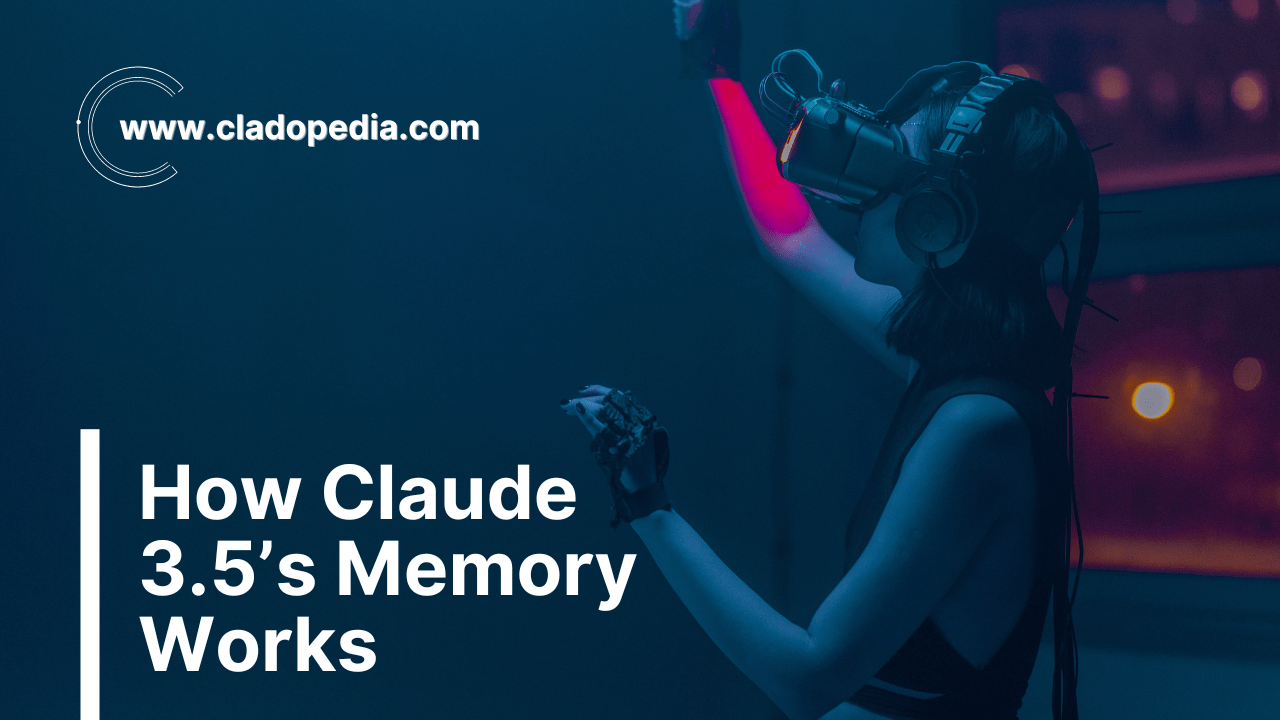How Claude 3.5’s Memory Works. Claude 3.5 represents a significant leap in the evolution of artificial intelligence, particularly in its approach to memory. Memory in AI models like Claude 3.5 is not merely about storing and recalling data; it’s about context, relevance, and the ability to create a coherent narrative over time. This article will explore the intricate workings of Claude 3.5’s memory systems, how they enhance its performance, and their implications for various applications.
Memory in AI
Memory plays a crucial role in how artificial intelligence systems function. It allows these systems to retain information from past interactions, enabling them to provide more personalized and relevant responses. In the case of Claude 3.5, memory mechanisms have been meticulously designed to support both short-term and long-term interactions, thus enhancing its conversational abilities and overall performance.
Importance of Memory in AI Models
- Contextual Understanding: Memory enables models to understand and utilize the context of conversations, making interactions more fluid and meaningful.
- User Experience: By recalling past interactions, AI can create a more personalized experience, addressing users by name and remembering their preferences.
- Task Continuity: Memory facilitates continuity in task execution, allowing the model to carry over information from one interaction to the next.
Types of Memory in Claude 3.5
Claude 3.5 employs multiple types of memory, primarily categorized into short-term and long-term memory. Each type serves specific functions and enhances the model’s capabilities in distinct ways.
1. Short-Term Memory
Short-term memory refers to the model’s ability to retain information from the current conversation or interaction. It is temporary and generally has a limited capacity. This memory allows Claude 3.5 to keep track of the ongoing dialogue, maintaining context and coherence.
How Short-Term Memory Works
- Information Retention: Claude 3.5 retains relevant pieces of information, such as user queries and responses, throughout the conversation. This retention allows it to refer back to earlier parts of the dialogue, ensuring continuity.
- Contextual Tracking: The model utilizes attention mechanisms to prioritize and focus on relevant information during interactions. This helps it maintain context and understand the flow of conversation.
- Dynamic Updating: As the conversation evolves, Claude 3.5 updates its short-term memory in real-time. New information can overwrite or modify existing memories, reflecting the latest context of the dialogue.
Benefits of Short-Term Memory
- Improved Coherence: By retaining contextual information, Claude 3.5 can generate responses that are more coherent and relevant to the ongoing conversation.
- Real-Time Adaptation: Short-term memory allows the model to adapt to changing topics or user sentiments dynamically, enhancing the overall user experience.
2. Long-Term Memory
Long-term memory is designed to store information over extended periods. Unlike short-term memory, which is transient, long-term memory allows Claude 3.5 to retain information from past interactions, making it capable of recalling facts, preferences, and user histories.
How Long-Term Memory Works
- Persistent Storage: Information stored in long-term memory remains accessible across multiple interactions. This enables Claude 3.5 to recall details about users, such as their preferences or previously discussed topics.
- Organized Knowledge Structure: Long-term memory in Claude 3.5 is organized in a way that allows for efficient retrieval. It employs techniques like hierarchical organization and tagging to categorize and access memories quickly.
- Learning from Interactions: Claude 3.5 continually learns from past interactions, refining its long-term memory based on user feedback and engagement. This learning process enhances the model’s relevance and accuracy over time.
Benefits of Long-Term Memory
- Personalized User Experience: By remembering user preferences and previous interactions, Claude 3.5 can tailor its responses and recommendations to suit individual needs, leading to a more engaging experience.
- Contextual Continuity Across Sessions: Long-term memory enables the model to maintain continuity across different sessions, allowing users to resume conversations without having to reintroduce topics or preferences.
Memory Management Techniques
Efficient memory management is crucial for the performance of Claude 3.5. The model employs various techniques to ensure that memory usage is optimized, relevant, and manageable.
1. Memory Compression
Memory compression involves reducing the amount of information stored while retaining its essence. Claude 3.5 uses techniques to summarize and condense information, allowing it to retain relevant memories without overwhelming its storage capacity.
Benefits of Memory Compression
- Efficient Storage: By compressing memories, Claude 3.5 can store more relevant information without using excessive resources.
- Faster Retrieval: Compressed memories can be accessed more quickly, enhancing the model’s response time during interactions.
2. Memory Pruning
Memory pruning is the process of removing outdated or irrelevant memories from the system. This ensures that the model’s memory remains focused on relevant information, thereby improving its efficiency and effectiveness.
Benefits of Memory Pruning
- Improved Relevance: By eliminating irrelevant memories, Claude 3.5 can provide more accurate and contextually appropriate responses.
- Reduced Cognitive Load: Pruning helps reduce the cognitive load on the model, allowing it to operate more efficiently without being bogged down by unnecessary information.
3. Memory Reinforcement
Memory reinforcement involves strengthening important memories through repetition or user feedback. Claude 3.5 can identify significant memories and reinforce them to ensure they remain accessible and influential in future interactions.
Benefits of Memory Reinforcement
- Enhanced Recall: Reinforced memories are more likely to be recalled accurately, improving the model’s performance in conversations.
- User Engagement: By reinforcing memories related to user preferences or interests, Claude 3.5 can engage users more effectively, leading to richer interactions.
Real-World Applications of Memory in Claude 3.5
The memory mechanisms in Claude 3.5 are not just theoretical; they have practical implications across various industries and use cases. Here are some of the key applications where memory plays a critical role:
1. Customer Support
In customer support, Claude 3.5 utilizes its memory capabilities to provide personalized assistance. By recalling previous interactions, the model can address customer queries more effectively and provide solutions tailored to individual needs.
Impact on Customer Experience
- Quick Resolutions: The ability to remember previous interactions allows Claude 3.5 to provide faster and more accurate responses, reducing resolution times.
- Personalized Service: By recalling customer preferences and past issues, the model can offer a more personalized experience, fostering customer loyalty and satisfaction.
2. Personal Assistants
Claude 3.5 can be employed as a personal assistant, where its memory mechanisms are crucial for managing tasks, appointments, and reminders.
Impact on Productivity
- Task Management: By remembering user preferences and schedules, Claude 3.5 can help manage tasks effectively, ensuring that users stay organized and productive.
- Contextual Reminders: The model can provide reminders based on past interactions, enhancing its utility as a personal assistant.
3. Educational Tools
In educational settings, Claude 3.5’s memory can be leveraged to create personalized learning experiences for students.
Impact on Learning Outcomes
- Adaptive Learning Paths: By recalling students’ progress and preferences, Claude 3.5 can adapt its teaching methods and content to suit individual learning styles, improving engagement and retention.
- Feedback and Assessment: The model can remember previous assessments and provide targeted feedback, helping students identify areas for improvement.
4. Content Creation
For content creation, Claude 3.5’s memory mechanisms can help writers maintain continuity and coherence across various pieces of content.
Impact on Content Quality
- Consistent Narratives: By recalling previous content and themes, the model can assist in creating cohesive narratives, enhancing the overall quality of the writing.
- Tailored Suggestions: Claude 3.5 can provide content suggestions based on the writer’s style and previous works, fostering creativity and efficiency.
Challenges in Memory Management
Despite the sophisticated memory mechanisms in Claude 3.5, challenges remain in managing memory effectively. These challenges can impact performance and user experience.
1. Memory Overload
One of the significant challenges is the potential for memory overload, where the model retains too much information, making it difficult to retrieve relevant memories efficiently.
Solutions to Memory Overload
- Dynamic Pruning: Implementing dynamic pruning techniques to regularly assess and remove irrelevant memories can help mitigate overload.
- User Feedback Loops: Encouraging user feedback can assist in identifying which memories are significant and should be retained.
2. Memory Bias
Bias in memory retention can occur when certain types of information are disproportionately emphasized or neglected, leading to skewed outputs.
Solutions to Memory Bias
- Balanced Training Data: Ensuring that the training data is diverse and representative can help reduce bias in memory retention.
- Regular Audits: Conducting regular audits of retained memories can help identify and correct biases, ensuring that the model operates fairly and ethically.
3. Privacy Concerns
The retention of user data raises privacy concerns, particularly in applications where personal information is stored.
Solutions to Privacy Concerns
- Data Anonymization: Employing techniques to anonymize user data can help protect privacy while still allowing for personalized interactions.
- User Control: Providing users with control over what information is retained can enhance trust and compliance with privacy regulations.

The Future of Memory in AI
The future of memory in AI models like Claude 3.5 is promising, with ongoing research aimed at enhancing memory capabilities further. Here are some potential developments:
1. Advanced Memory Architectures
Future iterations of Claude may incorporate more advanced memory architectures that allow for more sophisticated retention and retrieval mechanisms. This could include hybrid models that combine short-term and long-term memory more seamlessly.
2. Enhanced Personalization
As AI continues to evolve, memory mechanisms
will become increasingly sophisticated in their ability to provide personalized experiences. This could lead to AI systems that can adapt dynamically to individual user preferences in real time.
3. Ethical Memory Management
As concerns about data privacy and bias grow, the development of ethical memory management practices will be critical. This includes transparent memory retention policies and user-centric control over data.
Conclusion
Claude 3.5’s memory mechanisms represent a sophisticated approach to enhancing the model’s capabilities and user interactions. By effectively managing short-term and long-term memory, Claude 3.5 can provide personalized, contextually relevant, and coherent responses, making it a powerful tool across various applications.
As AI continues to advance, understanding and improving memory mechanisms will be key to unlocking even greater potential in the field of artificial intelligence. Through ongoing research and development, Claude 3.5 sets a precedent for future models, paving the way for more intelligent and responsive AI systems.
FAQs
1. What is the primary function of Claude 3.5’s memory?
Claude 3.5’s memory allows it to retain and recall information from past interactions, enabling contextual understanding and personalized responses during conversations.
2. What types of memory does Claude 3.5 utilize?
Claude 3.5 employs two main types of memory: short-term memory, which retains information during ongoing interactions, and long-term memory, which stores information across multiple sessions for future reference.
3. How does short-term memory work in Claude 3.5?
Short-term memory retains relevant pieces of information from the current conversation, allowing the model to maintain context and coherence while dynamically updating as the dialogue evolves.
4. What benefits does long-term memory provide?
Long-term memory enables Claude 3.5 to remember user preferences, past interactions, and important facts, facilitating personalized experiences and continuity across different sessions.
5. How does Claude 3.5 manage memory effectively?
Claude 3.5 employs techniques such as memory compression, pruning, and reinforcement to optimize memory usage, retain relevant information, and eliminate outdated data.
6. Can Claude 3.5 forget information?
Yes, Claude 3.5 can forget or prune information deemed irrelevant or outdated, ensuring that its memory remains focused and efficient.
7. How does Claude 3.5 ensure user privacy regarding memory?
Claude 3.5 employs data anonymization techniques and provides users with control over what information is retained, enhancing trust and compliance with privacy regulations.
